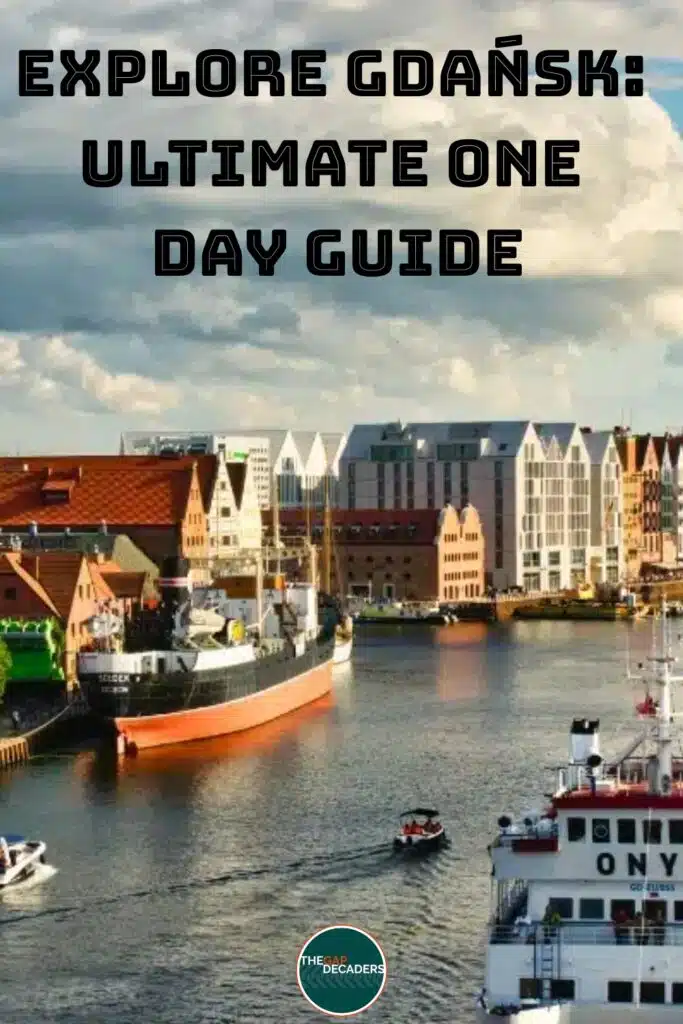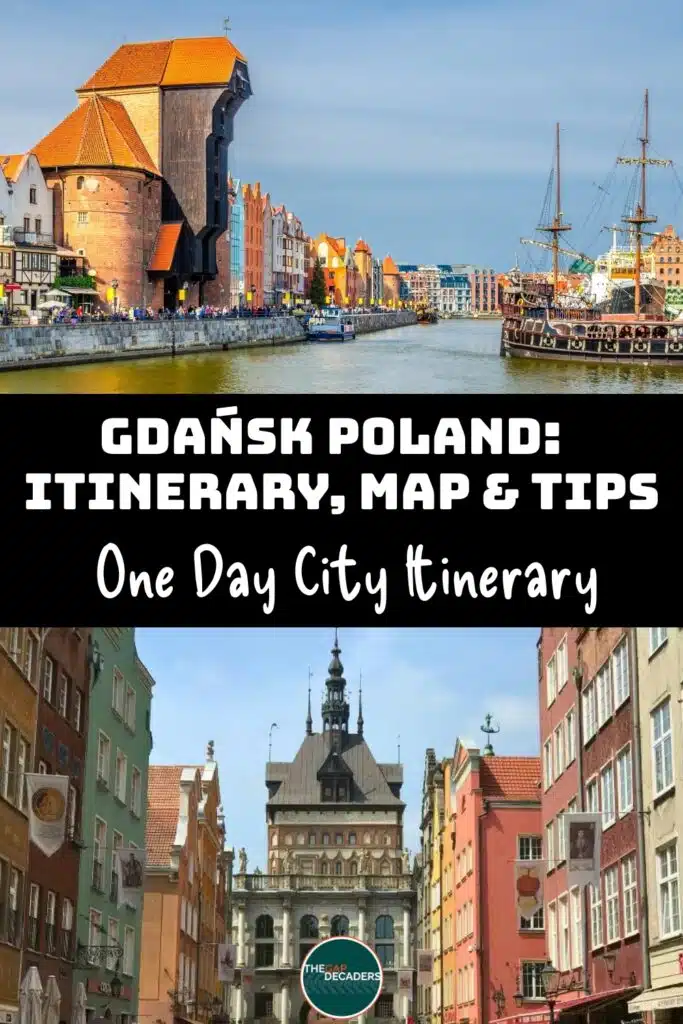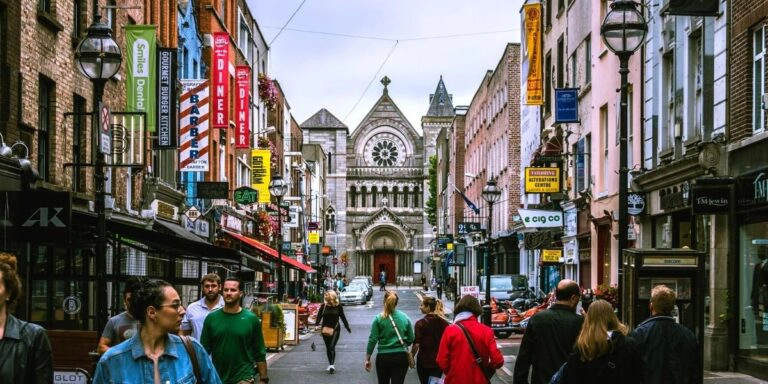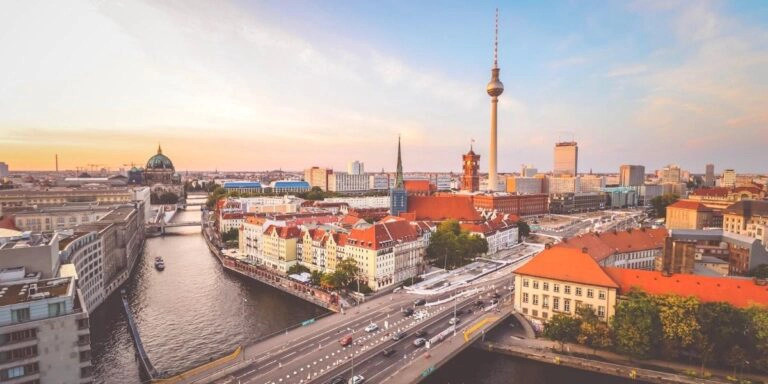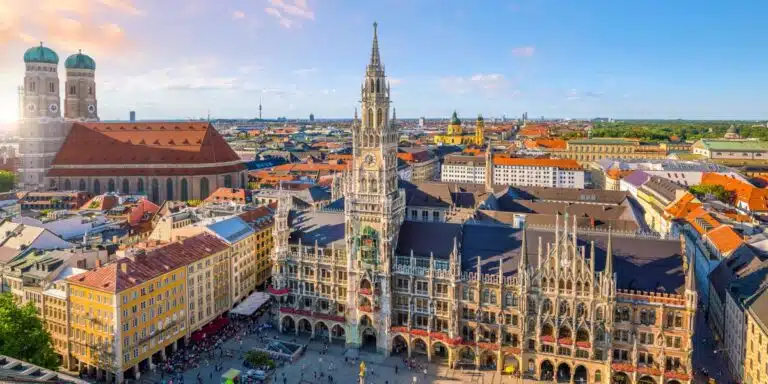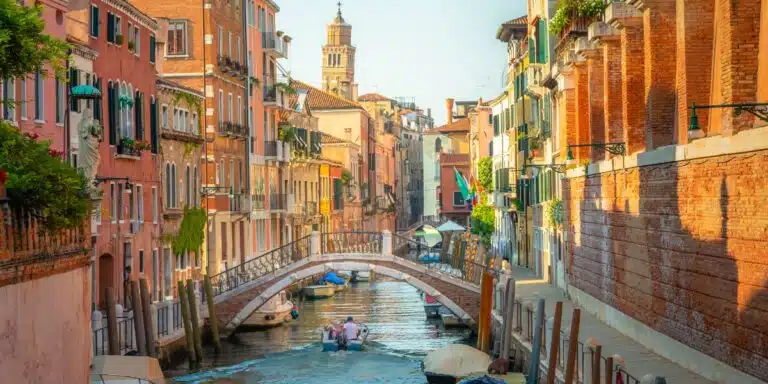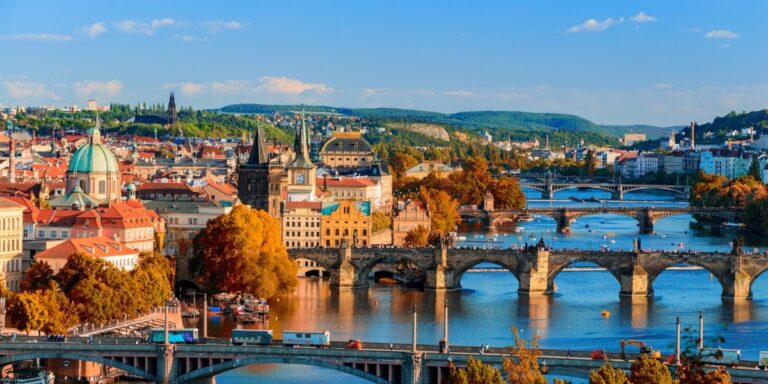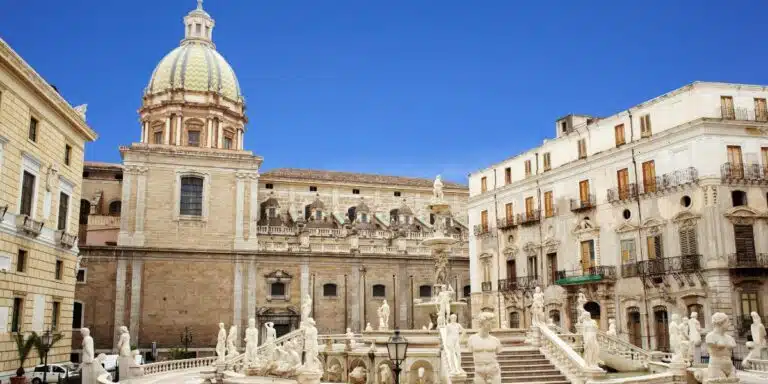This post may contain affiliate links, from which we earn an income. Click here to read our affiliate policy.
How to spend one perfect day in Gdańsk
Spending a day in Gdańsk offers a captivating glimpse into one of Poland’s most historic and picturesque cities. On the Baltic Sea, Gdańsk was a royal city and is renowned for its stunning architecture, vibrant waterfront, and rich maritime heritage.
Gdańsk boasts a unique blend of Gothic, Renaissance, and Baroque styles, evident in its ornate buildings, narrow streets, and lively squares. The city’s long maritime history and its role in World War II add plenty of historical interest.
In this Gdańsk travel guide, you’ll find a complete itinerary of all the most important must-see attractions, with an interactive map organized to make the most of your time. We also share recommendations for central places to stay, ideas about where to eat local food, and tips about how to make the most of your perfect day in Gdańsk.
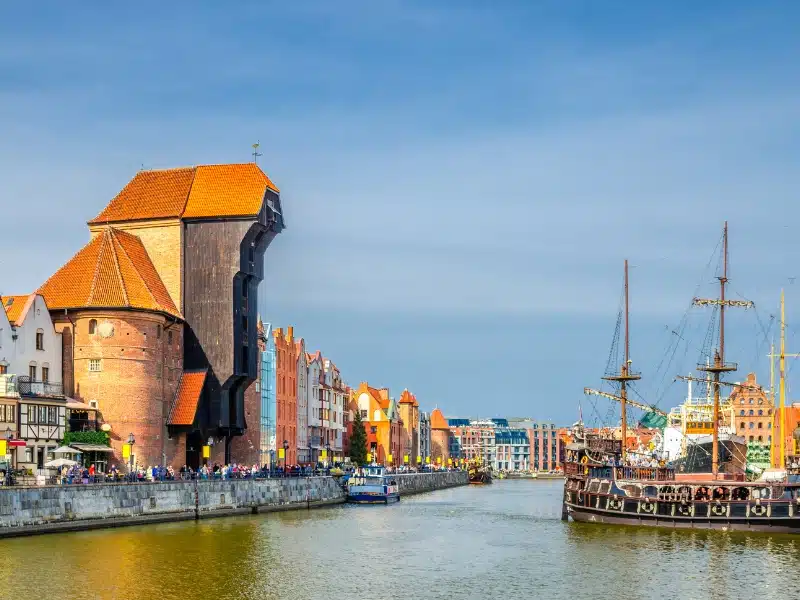
Are you planning your trip to Gdańsk last minute?
Be sure to book your accommodation and tours in Gdańsk ahead of time to ensure availability! Here are our top picks!
- Luxury: Hilton Gdansk (right in the centre and very lux!)
- Mid-Range: PURO Gdańsk Stare Miasto (perfectly located & our fave)
- Budget: Kobza Haus (bags of character at a great price)
- Hostel: Olympic Hostel (best hostel in town)
- For all the best things to see in the city, grab this Gdańsk city highlights tour
- Book the Gdańsk hop-on hop-off bus to see all the top attractions
- Get your European Solidarity Centre tickets in advance to avoid the lines
- End your day with a sunset river cruise on a traditional Polish boat
- Take a day trip to Sopot and Gdynia to see more of Poland in less time!
Things to See & Do in Gdańsk
Interactive Map
ROUTE: Royal Way – Old Town – Green Gate – Mariacka Street – St Mary’s Basilica – The Crane – St Bridget’s Church – Gdańsk Shipyard – European Solidarity Centre – The Bread Bridge
How to use this map – Use your fingers (or computer mouse) to zoom in and out. Click or touch the icons to get more info about a place, and click the arrow in the box top left to open the index. To add to your own Google Maps account, click the star next to the title of the map
Gdańsk Itinerary Notes
Morning
Walk the Royal Way & Explore the Old Town
Do as the royals did and walk the Royal Way in the central Śródmieście district. This was the road traveled by Polish kings and queens who came to visit the city and check in on their subjects during Gdańsk’s Golden Age. It’s also one of the best free things to do in Gdańsk.
Start with the High Gate or Brama Wyżynna, the impressive main entry point for the city from the times when it was fortified against intruders. The gate was built in 1574 but made a little more fancy in 1586 when the artist Willem van den Block was tasked with making it a little less drab. As a result, you’ll see coats of arms on the High Gate today from Poland, Prussia, and the city of Gdańsk. The lions represent the city, by the way.
Walk through the High Gate and head towards the Golden Gate or Brama Złotą. You’ll pass the Amber Museum of Gdansk, which once operated as a medieval torture chamber.
Once at the Golden Gate, make sure you’re looking up and around you; you’ll see World War II-era pictures from 1945. As you pass through, you’ll be on Long Market, or Dlugi Targ. There’s much history here, as this is one of the oldest streets in Gdańsk, and as a result, one of the busiest thoroughfares in the city today.
You’ll pass by the Gdańsk History Museum, which operates out of the 18th century Main Town Hall, and the impressive Neptune fountain. The fountain of the Roman sea god survived World War II because it was hidden before the looting and destruction began in the city. The Artus Court, a mansion named after King Arthur, is just beyond the fountain.
You’ll end your stroll down the Royal Way at the Green Gate and its four arches. The gate, or more of a gatehouse, leads to the Green Bridge, another easy stroll with a great view of the Motlawa River.
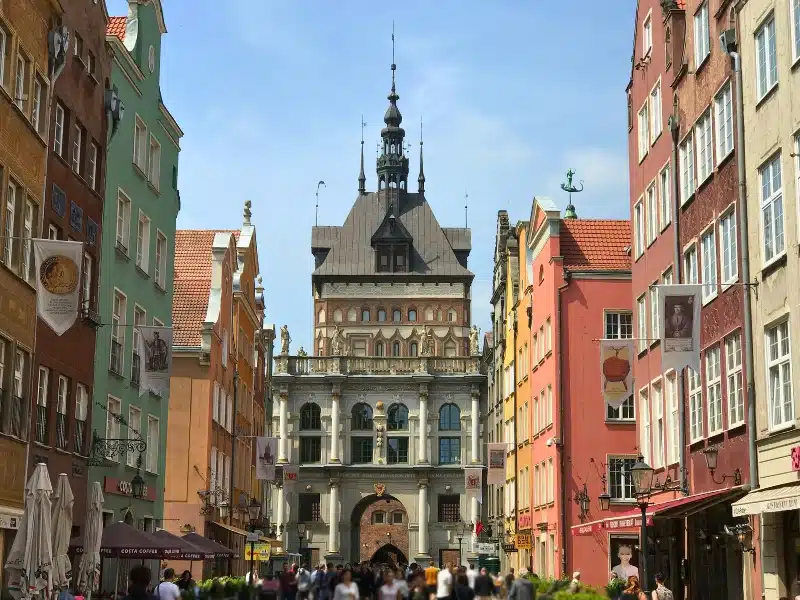
Window Shop on Amber Street
The Baltic Sea is impressive enough, but it’s also where Poles – and jewelry lovers around the world – get their Baltic amber, which even washes up on the seashores here.
The best place to see all of its applications in jewelry form is Amber Street, or, more officially, Mariacka Street in the Gdansk city center. You don’t need to buy anything, but you’ll want to; this street is everything amber!
Haggling isn’t really a thing in Poland, but if you see something you like at the start of the street, it’s worth checking out the other shops on Mariacka. You might find similar items at a lower price.
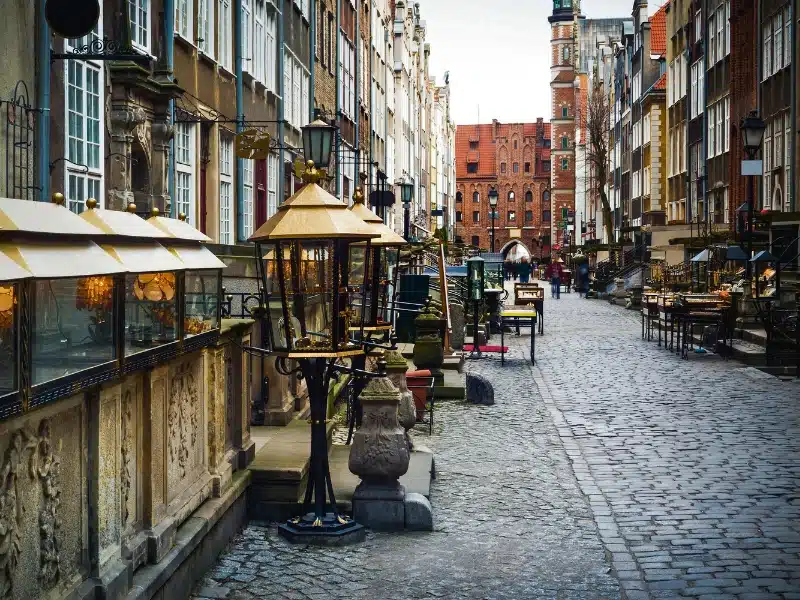
Climb to Panoramic Views at St. Mary’s
On the same street, as if things could get even more picturesque, you’ll come across St. Mary’s Basilica, one of the largest brick churches in the world. If you have the energy, you should climb the 405 steps up the tower for beautiful views of the city below.
You can also spend some time inside the Gothic church, much of which had to be reconstructed after the war. There are more than 30 chapels inside, all decorated with religious artwork and a collection of historical tombstones.
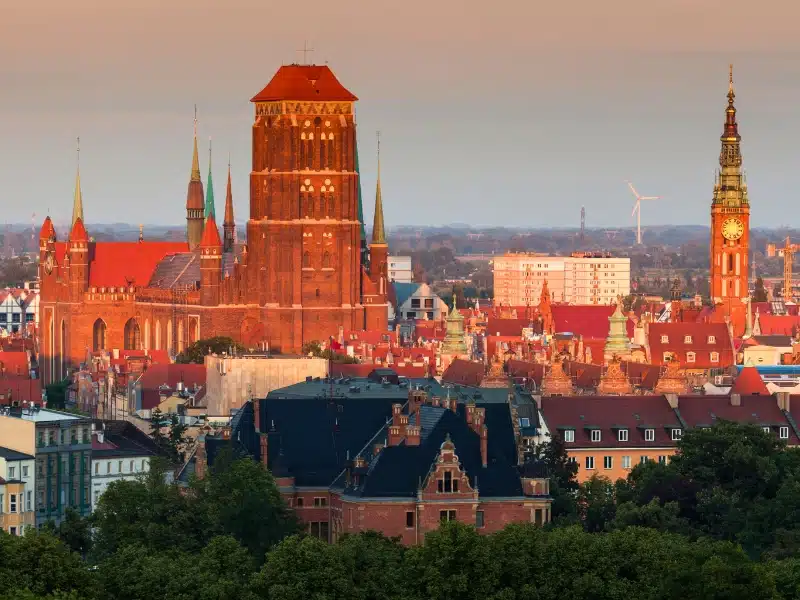
Afternoon
Meet the Crane, a Symbol of the City
Most panoramas of the city will include the Crane, or Zuraw, a symbol of the city’s history as a maritime trading powerhouse. The original structure dates back to 1367, but that one burned down. Parts of what you see here today have been overlooking the city since 1442, although much of the Crane was rebuilt following the destruction of the city during World War II.
If you’d like to learn more about the Crane, one of the largest working cranes in the world when it was still in operation, there are exhibits inside about the city’s port history. You can get tickets at the Maritime Cultural Centre next door.

St Bridget’s Church
We love a good church, and St. Bridget’s Church is no exception. A historically significant Roman Catholic church with roots dating back to the 14th century, it has seen numerous transformations over the centuries, particularly after sustaining significant damage during World War II.
The church is perhaps most famous for its deep connection to the Solidarity movement, which played a crucial role in the fall of communism in Poland. During the 1980s, St. Bridget’s Church became a sanctuary and a beacon of hope for Solidarity leaders and members as they fought against the oppressive communist regime.
This association with the movement is poignantly symbolized by the church’s large amber altar, a tribute to the Polish workers who sacrificed for freedom. This altar, the largest of its kind in the world, is a powerful reminder of the church’s role in the nation’s struggle for independence – you’ll get goosebumps just looking at it!
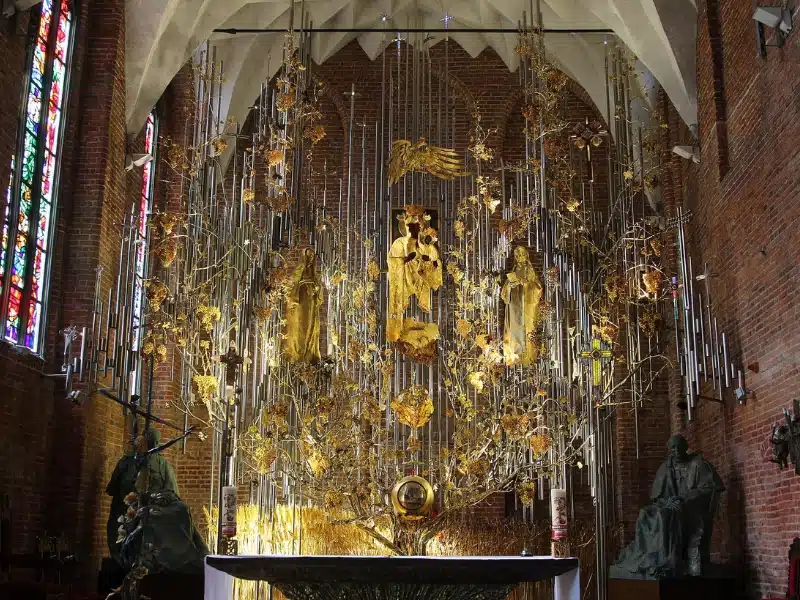
See the Shipyards, the Cradle of Solidarity
There’s more to the history of Gdańsk than its’ rising from the ashes of World War II. The port city is also a testament to the resilience of the people who continued to fight for the city’s rights well after the Second World War.
In 1970, 45 people died in the city during protests against communism. Visit the Gdańsk shipyard and see the site memorializing that event at the Monument to the Fallen Shipyard Workers.
Follow that with a somber moment at the No. 2 Gate of the Gdańsk Shipyards. It was here that Lech Walesa, who would eventually become the president of Poland, kicked off a movement in 1980 that would lead to the fall of communism in the country, along with labor rights for Poland’s workforce.
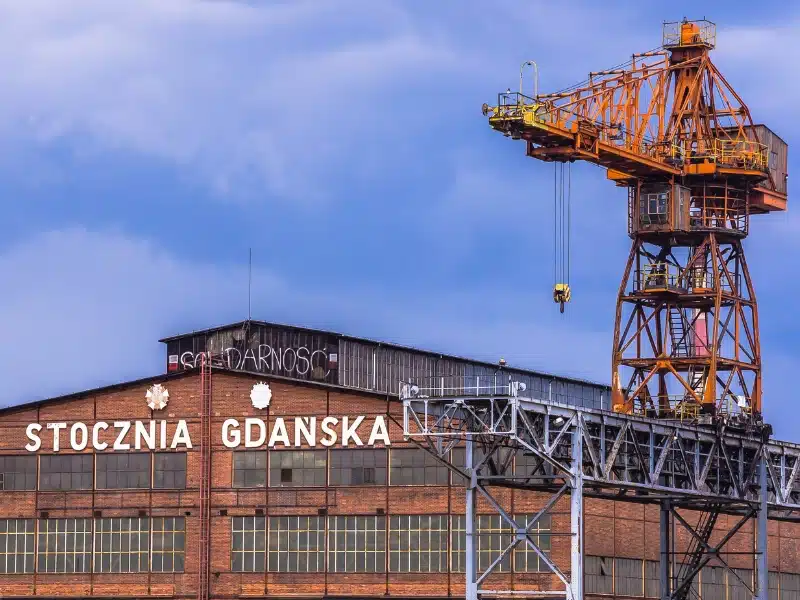
Learn More About Solidarity at the European Solidarity Centre
The movement led by Walesa was known as the Solidarity movement. The excellent exhibits at the European Solidarity Center explain in more detail how a series of protests led to massive changes for Poland’s workers and working conditions across the country.
This museum is often a pleasant surprise for most visitors to Gdańsk, as the building doesn’t look like much from the outside. Inside, seven halls take you from post-war Gdańsk through the 1980s.
This is by far the most popular museum in Gdansk, and we strongly advise you to book your tickets in advance to avoid standing in a long line or risk not getting in at all!
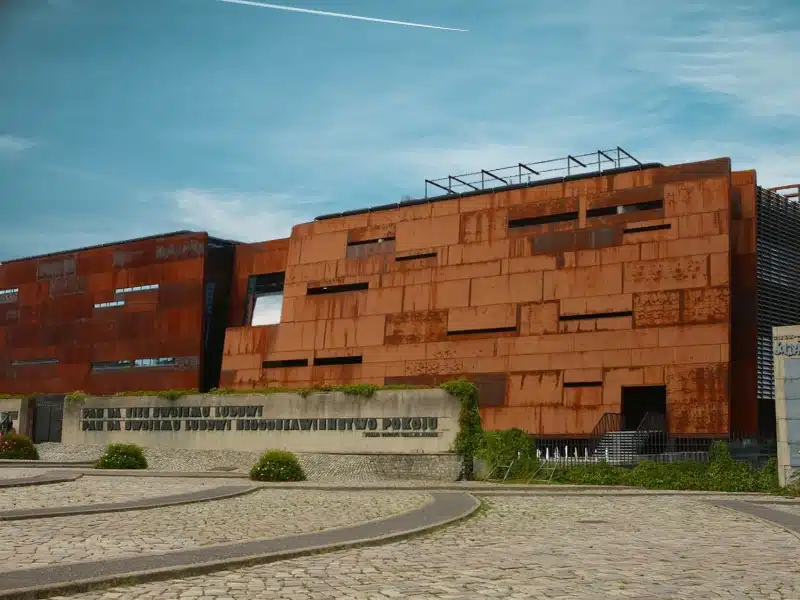
Get Romantic at the Bread Bridge
The Bread Bridge, Most Chlebowy, was a simple bridge by the Great Mill (hence the name) that has been here since the 14th century. At some time in the late 20th century, it became a “love bridge” known for its romantic setting and is now adorned with padlocks used by lovers to show their commitment. Please don’t leave a padlock, though, or you risk compromising the structural integrity of the bridge.
Across the so-called Bridge of Love stands the Old Town Hall, a stunning Renaissance building from the 16th century and one of the rare structures in Gdańsk that survived World War II. In the 17th century, this historic building was where the renowned astronomer Johannes Hevelius served as the Old Town Council Lord.

Evening
Stroll Along the Motława River
The riverbanks are lovely for an evening walk, and the promenade is home to a variety of cafés, restaurants, and shops, where you can pick up unique Polish souvenirs. The views across the water are stunning, especially at sunset when the light casts a golden glow over the historic facades and the gently rippling water.
You’ll pass by several key landmarks, including the Gdańsk Maritime Museum, which delves into the city’s seafaring past, and the modern Gdańsk Eye, Amber Sky, located on Ołowianka Island. The 50-meter-high Ferris wheel offers incredible views of Gdansk, especially after dark.
Take a River Cruise
This highly-rated sunset river cruise on a traditional Polish boat is a relaxing way to end your day and see the city from a different perspective.
Motława River cruises often glide by the vibrant Long Embankment, Długie Pobrzeże, where you can see colorful townhouses, lively cafés, and bustling markets. Along the way, you’ll also spot key landmarks like the Gdańsk Shipyard and the Green Gate. Depending on the route, the cruise might take you to Westerplatte, a site of immense historical significance as the location of the first battle of World War II.
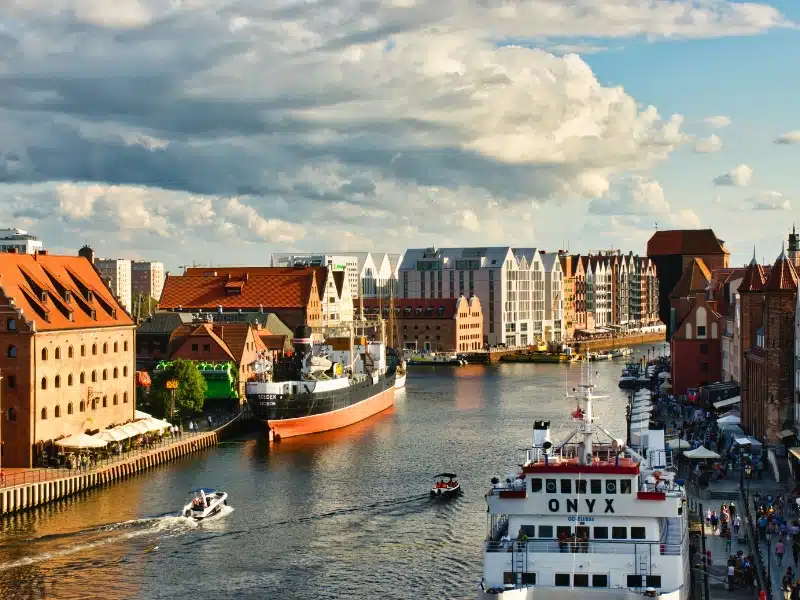
Wander the Old Town
You’ll have already visited the historic quarter of Gdańsk, but several buildings are beautifully lit after dark and worth a second look.
For the best illuminations, we suggest visiting the Royal Chapel on Świętego Ducha, the Great Armoury on Targ Węglowy, and St Mary’s Basilica on Mariacka Street.
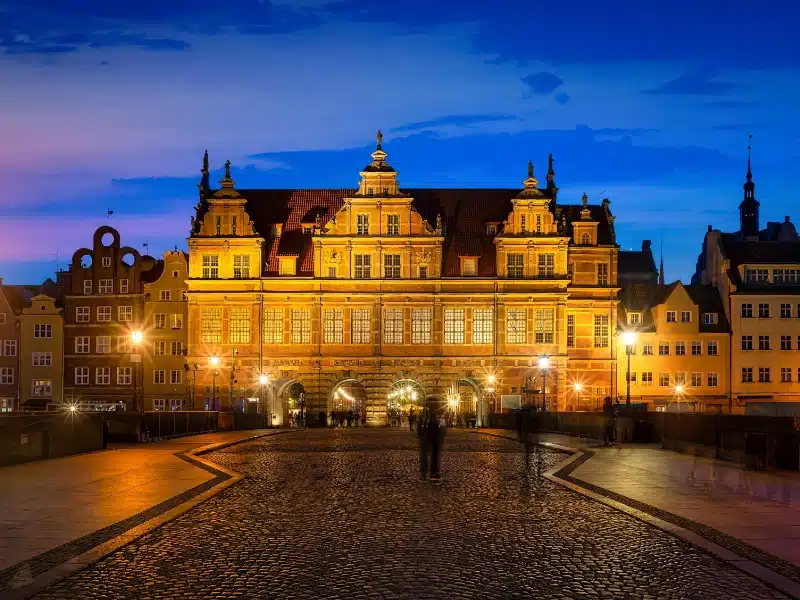
Where to Eat in Gdańsk
Bar Pod Ryba
The name of this eatery translates to “The Bar Under the Fish,” but the casual Bar Pod Ryba is not known for its seafood. This place serves up stuffed potatoes that sound simple but are anything but.
The giant potatoes – you really have to see them to believe them – come topped with your choice of one of seven sauces like garlic, Icelandic, or a Polish favorite, dill. They’re then stuffed with a variety of fillings, like mussels, pork shoulder, chanterelle mushrooms, and pickled herring if you really want a deep dive into Polish food.
And if you have the room and want something sweet, finish off lunch with a Polish crepe at the nearby Nalesnikowo. Nalesniki is thin, rolled, and often stuffed with a sweet filling of your choice. Whatever you decide, they’re a must-do in Gdańsk.
Brovarnia
If you’re in the city on a chilly day, the The Brovarnia usually has some delicious bread bowl soups for you to try. Have some zurek (Polish sour rye soup) if it’s on the menu. And if you want some beer to go along with your meal, they definitely have that, too. The name translates to ‘brewery,’ after all.
As with many of the buildings in Gdańsk, the brewery has a historic past. Somehow, the warehouse wasn’t destroyed in the war, so much of what you’ll see inside dates back to the 17th-century when it was a working granary.
Bar Mleczny Stągiewna
Bar Mleczny Stągiewna offers an authentic taste of traditional Polish cuisine in a no-frills setting. Bar Mleczny, which translates to “milk bar,” is a canteen-style eatery that dates back to the communist era. It originally served affordable meals to the working class.
Expect a menu filled with classic Polish dishes, such as pierogi (dumplings filled with meat, cheese, or potatoes), kotlet schabowy (breaded pork cutlet), gołąbki (cabbage rolls stuffed with meat and rice), and barszcz (beet soup). The portions are generous, and the food is simple but hearty.
Top Five Gdańsk Travel Tips
More Than One Day in Gdańsk
Day Trip to Sopot & Gdynia
The Tricity, or Trójmiasto, is an urban area that comprises Gdańsk and the closely connected cities of Sopot and Gdynia. Each city has its own unique character and attractions, making Tricity a perfect option for a day trip.
Just a short distance from Gdańsk, the seaside town of Sopot is famous for its long wooden pier, beautiful beaches, and vibrant nightlife. It’s a great place to relax by the sea, enjoy fresh seafood, and take in the coastal scenery.
Gdynia, the youngest of the three cities, is a modern port city with a different vibe from its neighbors. Known for its maritime heritage, it is home to several museums and attractions focused on the sea, such as the Gdynia Aquarium and the Dar Pomorza Museum ship.
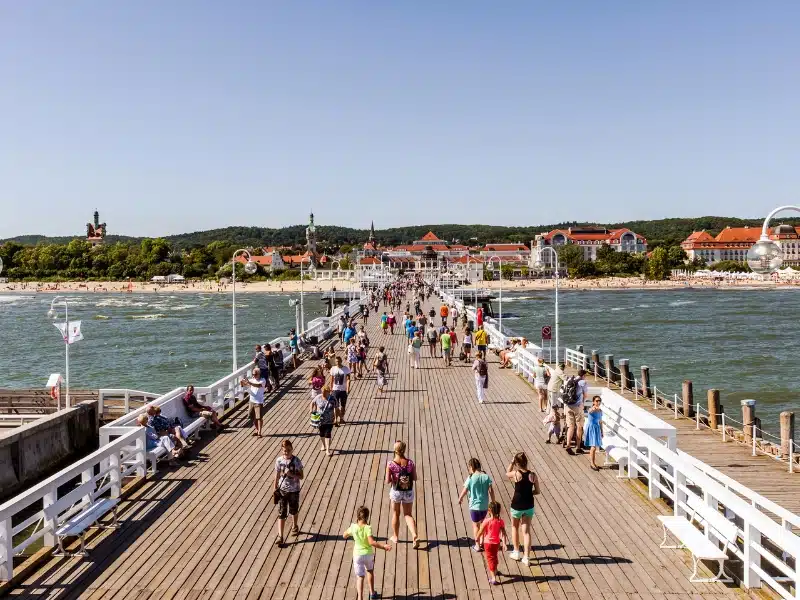
Malbork Castle
Malbork Castle is one of the most significant and impressive medieval fortresses in Europe. Constructed by the Teutonic Knights, a German Catholic religious order, the 13th-century castle is recognized as a UNESCO World Heritage Site and exemplifies Gothic architecture.
Malbork Castle’s historical significance extends beyond its military role. In 1457, during the Thirteen Years’ War between the Polish Kingdom and the Teutonic Knights, Polish forces captured the castle, which later became a royal residence. It remained an important site in Polish history until the partitions of Poland in the late 18th century.
Today, it’s a major tourist attraction, drawing visitors from around the world. You can book a half-day Malbork Castle trip from Gdańsk. It has been meticulously restored and now houses a museum that offers insights into the history of the Teutonic Knights, medieval life, and the architectural marvel of the castle itself.
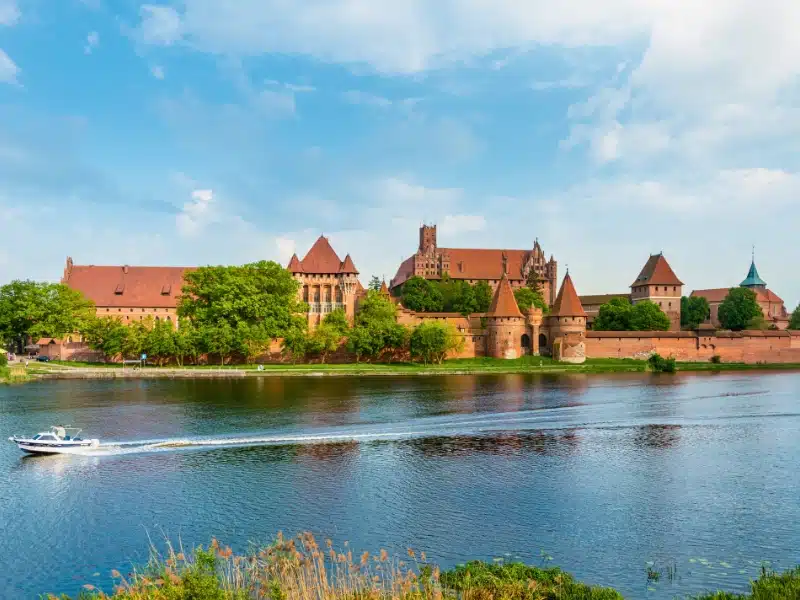
World War II Tour
A World War II tour of Gdańsk provides a profound insight into the city’s pivotal role during one of the most significant conflicts in modern history. Tours typically cover key sites and museums that highlight Gdańsk’s experiences and contributions during the war and provide visitors with a deep and moving understanding of the city’s historical significance.
Tours take in Museum of the Second World War, an extensive and immersive institution dedicated to the global impact of the conflict; Westerplatte, a peninsula near Gdańsk that is famous for being the site of the first battle of World War II; the European Solidarity Centre which provides context about the pre-World War II period and the struggles faced by Poland under German occupation; and the Gdańsk Historical Museum, located in the Main Town Hall, offers further context.
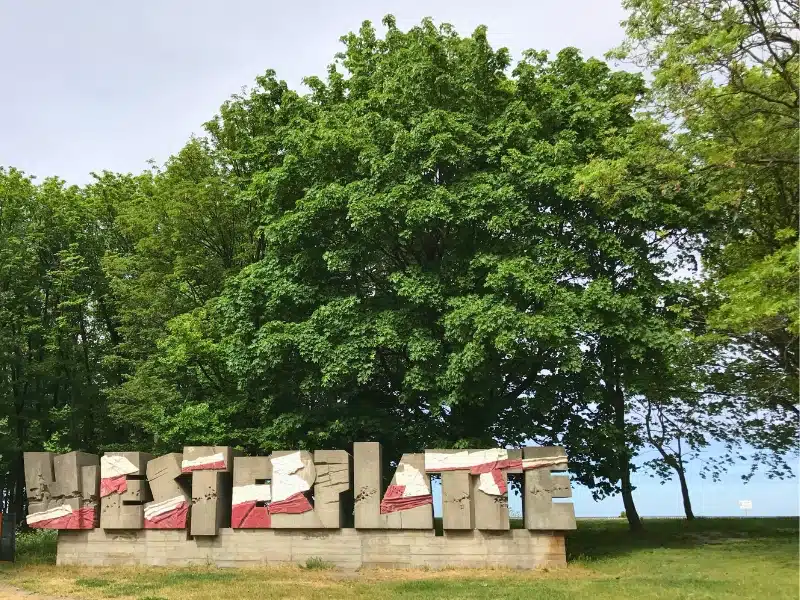
Gdańsk Practicalities
When to Visit Gdańsk
There’s also really no bad time to visit the city, as long as you’re fine with chillier temperatures and the wet Gdansk weather which is common in the low season. Just come prepared if you visit Gdansk in winter! This is a wet, breezy part of the country, so inclement weather and snow is to be expected.
Poland enjoys all four seasons, so expect higher prices in the peak summer months of July and August and more budget-friendly options for those traveling in the off-season.
If you’re interested in checking out the neighbouring seaside towns as day trips from Gdansk while you’re near the Baltic, June is a good compromise for sunny skies before the rest of the country heads up to the crowded shores for Gdansk beach vacations.
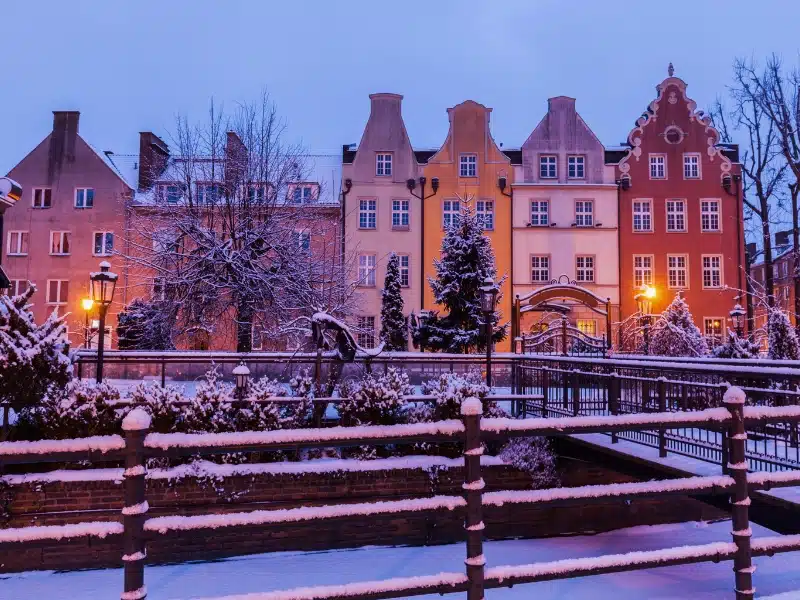
Getting to Gdańsk Poland
The best airport for Gdańsk is Gdańsk Lech Wałęsa Airport. It is located approximately 12 kilometers (7.5 miles) northwest of Gdańsk’s city center, making it the most convenient option for travelers visiting the city. We recommend using Skyscanner to book your flights for the best deals and the largest selection of airlines.
To get from Gdańsk Airport to Gdańsk city center, you have several options:
Where to Stay in Gdańsk
Luxury: The Hilton Gdansk is a gorgeous luxury hotel in the heart of Gdańsk’s Old Town. It offers a blend of modern comfort and historic charm. The hotel has stunning views of the waterfront and is ideally positioned for exploring the city’s rich cultural and historical attractions.
Mid-Range: PURO Gdańsk Stare Miasto is located in the historic town and has a modern, minimalist aesthetic. It features bright spaces and innovative design elements. The rooms are designed with comfort and functionality in mind, perfect after a day of exploring and sightseeing.
Budget: Kobza Haus offers great value for money in the Old Town. It has comfy rooms, a pretty courtyard, and a delicious buffet breakfast to kick off a day of discovering the city.
Hostel: The Olympic Hostel offers budget-friendly accommodation with a focus on providing a comfortable and convenient stay for travelers exploring the city. Located in the Old Town, the hostel is ideally situated for easy access to the city’s main attractions, making it a practical choice for those visiting Gdańsk on a budget.
Looking for more one day city itineraries? Check out these top posts…
One Day in Dublin: Best Itinerary, Map, Tips & Guide
Berlin in One Day: Best Itinerary, Map, Tips & Guide
One Day in Munich: The Best Itinerary + Map, Tips & Guide
One Day in Venice: Best Itinerary, Map, Tips & Guide
The Best Prague One Day Itinerary + Map, Tips & Guide
One Day in Palermo: Best Itinerary, Map, Tips & Guide
Love it? Pin It!
